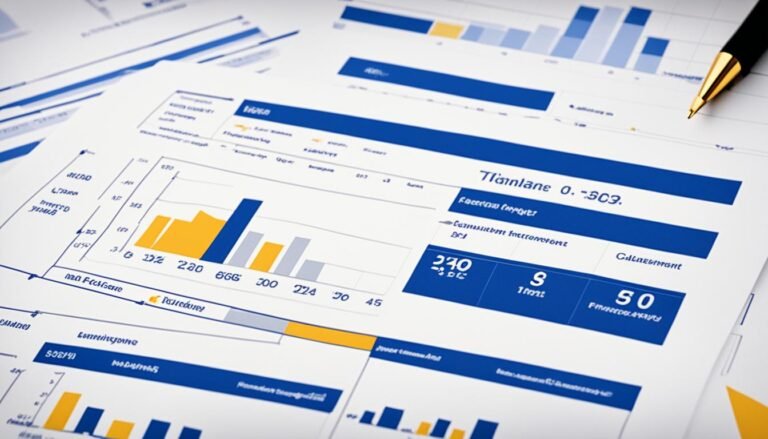Review of Master of Science in Financial Trading and Risk Management (MSFTRM) Programs
Financial trading programs have become really popular worldwide. This surge in interest is because of the growing importance of managing financial risks. More and more people are studying in this area. The Master of Science in Financial Trading and Risk Management (MSFTRM) programs aim to fully educate students. They focus on financial trading and risk management. They give students the skills and knowledge they need for success in the financial world.
A master’s degree in financial trading and risk management can lead you to a rewarding career. It can unlock many opportunities in the finance field. Whether you want to work in trading, risk management, or quantitative finance, this degree is valuable.
We will look at the main parts of these programs. We’ll see why both students and experts in the finance industry think highly of them.
Program Curriculum
The MSFTRM programs’ curriculum offers a deep dive into financial trading and risk management. Students will take a mix of finance and business courses. This variety helps them build a wide set of skills.
There are classes in financial math, stats, computer science, and business finance. These teach students quantitative and analytical skills, as well as how to manage risks.
Financial master’s degrees focus on giving students high-level finance knowledge. They often do very well in finance program rankings because they’re intense and relevant.
Students can also choose from a list of electives. This lets them focus on what they’re most interested in. For example, they might pick courses on portfolio management or financial derivatives.
Sample Courses:
- Financial Mathematics and Modeling
- Statistical Techniques in Finance
- Machine Learning for Financial Trading
- Algorithmic Trading and High-Frequency Finance
- Financial Risk Management
- Financial Statement Analysis
The program’s design helps students get deep knowledge and practical skills. With a wide variety of courses, they can learn advanced strategies in financial trading.
This program also puts a big focus on learning by doing. Students will work on case studies, simulations, and real projects. This way, they can practice what they learn in real finance settings.
Advanced financial trading degrees give students everything they need to succeed in finance. Those who graduate can go into financial trading, risk management, investment banking, and more.
Career Services
Graduate students in risk management and finance can get a lot from MSFTRM career services. These go beyond teaching. They help students start successful financial careers.
Editing resumes is a key part. Professionals help make resumes stand out. This helps students when they apply for jobs or more education.
Students also get to do mock interviews. This helps them practice and get feedback. It makes them better at real job interviews.
MSFTRM offers career advice too. Professionals help students choose the right career path. This is key for jobs like investment banking or financial consulting.
Networking is important in MSFTRM. Students meet alumni and pros at events. This offers career advice and job opportunities.
“Career services at MSFTRM are great. They hone my resume, interview skills, and I met people who helped my career a lot.” – Sarah Thompson, MSFTRM graduate
MSFTRM also arranges interviews with top firms on campus. This lets students show their skills face to face. It’s a big chance to get good jobs or internships.
In the end, MSFTRM career services help students in finance. With resume help, mock interviews, advice, networking, and direct interviews, they’re well-prepared for their careers.
| Benefits | MSFTRM Programs |
|---|---|
| Resume Editing | ✓ |
| Mock Interviews | ✓ |
| Career Guidance | ✓ |
| Networking Opportunities | ✓ |
| On-Campus Interviews | ✓ |
Personal Experiences
Graduate students often enjoy financial master’s degrees and risk management studies. They highlight key positive parts of their programs. This includes a supportive staff and a strong focus on practical skills.
- Dedicated Staff: The program’s staff is key to its success. They help students along the way by giving advice and personal attention.
- Supportive Learning Environment: In this program, students work well together. They build friendships and help each other learn, which improves the overall experience.
- Emphasis on Practical Skills: These studies prepare students for the real world. They practice skills through simulations and projects. This makes them ready for their future jobs.
Faculty members who work in the industry also enrich the program. They bring real-life finance and risk management experience to their teaching. This helps students a lot.
Students get extra help through tutoring and academic support services. They can use these for tough topics or to boost their study skills. This ensures they do well in their studies.
Admission Process
The process for getting into a Master of Science in Financial Trading and Risk Management (MSFTRM) program includes several steps. Prospective students have a few things to complete. This part will show you what you need to do and what the program looks for.
Application Submission
If you want to join an MSFTRM program, first, you must fill out an application form. This form will ask for your personal details, education, and any relevant job experience. You’ll also need to send in your old school grades and letters from teachers or work bosses.
Interviews
Some applicants get to have a chat with the people in charge next. This could be an interview with teachers or other members of the admissions team. The goal is to see if you’re a good fit for the program and learn more about your goals and what you wish to achieve.
Specific Requirements
Each MSFTRM program asks for different things from their applicants. You might need a strong background in finance or math to be considered. However, having a degree in economics or business could still make you eligible. They also look at your work history and academic records.
Considerations
They don’t just look at grades, though. MSFTRM programs are interested in your passion and goals within the finance world. The committee wants to bring in people who are excited about this field and can contribute.
Getting into an MSFTRM program is tough. Prospective students need to make sure they meet all requirements and fill out their applications fully. Showing how much you care about this area can really boost your chances of acceptance.
Courses and Teaching Quality
MSFTRM programs let students pick from a lot of courses. They cover many parts of trading and managing risk. This includes topics like derivatives, financial markets, and using math to understand finances.
The quality of teaching in MSFTRM programs stands out. The teachers are experts and have real-world experience. They make hard topics easy to understand. This helps students to learn about trading and managing risk well.
There are also teaching assistants (TAs) who are very helpful. They run extra classes and give support. TAs help students discuss hard ideas, clear up confusion, and improve at solving problems.
“The teachers’ knowledge and support changed my MSFTRM experience. They know a lot about trading and risk management, which helped me learn.” – Student Name
Course Selection and Customization
Students in MSFTRM programs can choose classes that match what they want to learn. There are many courses that go deep into finance and risk. This lets each student focus on their career goals.
MSFTRM programs offer a wide variety of courses. This lets students understand the many parts of the financial world. They learn to study markets, build models, and more.
| Course | Description | Skills Acquired |
|---|---|---|
| Derivatives Pricing | Exploration of derivative instruments, pricing models, and risk management strategies. | Understanding derivatives, risk assessment, financial modeling. |
| Financial and Economic Forecasting | Utilization of statistical techniques and econometric models to predict financial and economic outcomes. | Statistical analysis, forecasting, data interpretation. |
| Quantitative Risk Management | Study of quantitative methods to evaluate and manage financial risks. | Risk assessment, probability theory, risk modeling. |
These are only a few of the courses in MSFTRM programs. The program is updated to keep up with the finance world. This helps students learn the latest in the field.
The quality of teaching and the choice of courses make MSFTRM programs popular. They’re great for anyone interested in trading or risk management. Whether you want to work with derivatives or learn about predicting finance, these programs lay a strong foundation.
Programming Component
Master of Science in Financial Trading and Risk Management (MSFTRM) programs focus a lot on programming skills. They see how important it is in areas like finance and data analysis. These programs teach students about programming languages such as R and Python, which are key in financial work.
Students learn by doing hands-on projects and tasks. This helps them get real-world practice in using R and Python. They analyze financial data and make trading strategies. The goal is to get them ready to work by improving their technical skills and decision-making.
In some MSFTRM programs, students also get to learn C++. This language is known for being fast and powerful, used a lot in finance. Knowing C++ makes students even better at programming. It can open up opportunities in areas like algorithmic and high-frequency trading.
Projects and Career Opportunities
MSFTRM programs offer projects for students to apply what they learn. These projects are a key part of the study. They help students use their skills on financial problems from the real world.
Students get to work directly with tools and data used in the industry. They might study market trends, make strategies for trading, or design models for managing risks. This hands-on approach improves their knowledge and problem-solving abilities.
Via MSFTRM, students find many job options. The programs have ties with professionals and firms in finance. They organize events to meet people, find internships, and get help with job searches.
“The internship opportunities provided by the MSFTRM program were invaluable. I had the chance to work alongside experienced traders and risk managers, gaining hands-on experience and building my network in the industry. It definitely accelerated my career.” – Sarah Johnson, MSFTRM graduate
They also set up interviews on campus with top firms. This means a higher chance of getting well-paying job offers. MSFTRM assists students with getting ready for interviews and building professional connections.
Check out the table for a look at jobs MSFTRM grads often go for:
| Job Title | Company |
|---|---|
| Quantitative Analyst | Goldman Sachs |
| Risk Manager | J.P. Morgan |
| Financial Trader | Citadel |
| Investment Banking Analyst | Morgan Stanley |
| Portfolio Manager | BlackRock |
Graduates from MSFTRM programs have bright futures. They can work in top financial companies, banks, hedge funds, and more. Their solid skills in financial trading and risk management open the door to success in a fast-changing field.
Conclusion
The MSFTRM programs offer a deep education in financial trading and risk. They give students the skills they need to stand out in finance. The course is both detailed and challenging.
These programs cover many finance topics. Students get to learn a lot from professionals in the field. The teachers make sure their education is top-notch.
MSFTRM also helps students get ready for their careers. They help with resumes, practice interviews, and meeting financial firms. This support is crucial for finding good jobs in finance.
In short, MSFTRM programs are perfect for those wanting to excel in finance. They focus on practical skills, industry ties, and a strong curriculum. With this, students can shine in the finance world.








